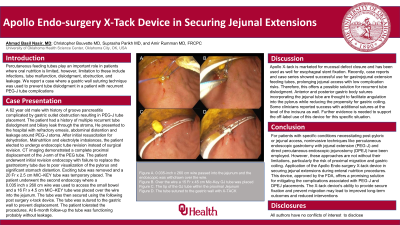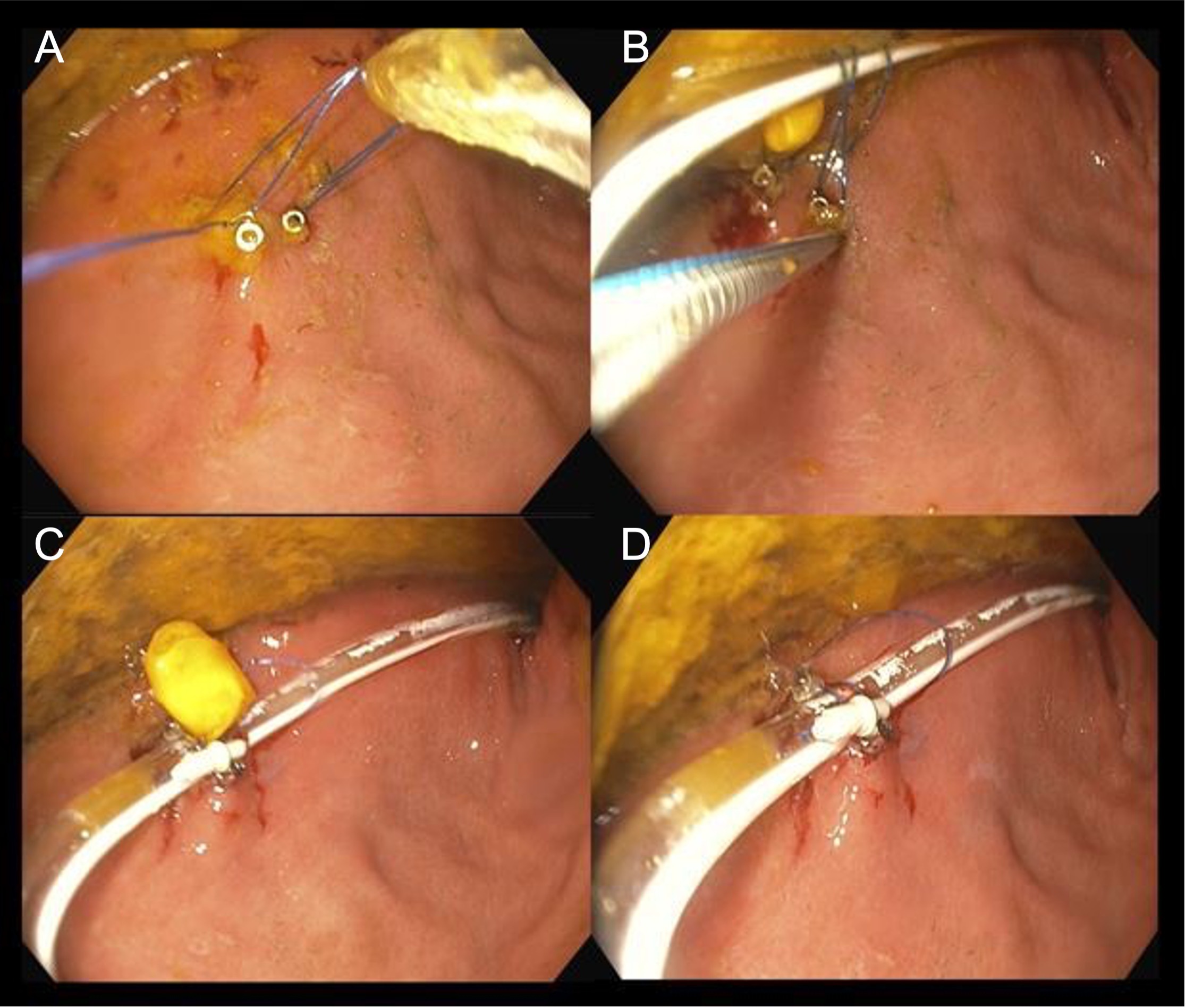Monday Poster Session
Category: Interventional Endoscopy
P2308 - Apollo Endosurgery X-Tack Device in Securing Jejunal Extensions
Monday, October 23, 2023
10:30 AM - 4:15 PM PT
Location: Exhibit Hall

Has Audio

Ahmad Basil Nasir, MD
University of Oklahoma College of Medicine
OKLAHOMA CITY, OK
Presenting Author(s)
Ahmad Basil Nasir, MD1, Christopher Bouvette, MD1, Ahel El Haj Chehade, MD2, Suparshva Parikh, MD2, Amir Rumman, MD3
1University of Oklahoma College of Medicine, Oklahoma City, OK; 2University of Oklahoma Health Sciences Center, Oklahoma, OK; 3University of Oklahoma Health Sciences Center, Oklahoma City, OK
Introduction: Percutaneous feeding tubes play an important role in patients where oral nutrition is limited. However, limitations to these include infections, tube malfunction, dislodgement, obstruction, and leakage. We report a case where a gastric wall suturing technique was used to prevent tube dislodgment in a patient with recurrent PEG-J tube complications.
Case Description/Methods: This is a case of a 62-year-old male with a history of groove pancreatitis complicated by gastric outlet obstruction resulting in PEG-J tube placement. The patient had a history of multiple recurrent tube dislodgement and biliary leak through the stoma. He presented to the hospital with refractory emesis, abdominal distention, and leakage around the PEG-J stoma. After initial resuscitation for dehydration, malnutrition, and electrolyte imbalances, the patient elected to undergo endoscopic tube revision instead of surgical revision. CT imaging demonstrated a fluid-filled stomach and complete proximal displacement of the J-arm of the PEG-Tube. The patient underwent initial revision endoscopy with failure to replace the gastrostomy tube due to poor visualization of the pylorus and significant stomach distention. The existing tube was removed, and a 20 Fr x 2.5 cm MIC-KEY tube was temporarily placed. The patient underwent the second endoscopy where a 0.035 in x 260 cm wire was used to access the small bowels and a 16 Fr x 4.5 cm MIC-KEY tube was placed over the wire into the jejunum. The tube was then secured using the Apollo Endosurgery X-tack device. The tube was sutured to the gastric wall to prevent displacement. The patient tolerated the procedure with the resolution of obstructive signs and leakage. At 6 months follow-up, the tube was functioning properly without leakage, and the patient was symptom-free.
Discussion: Apollo X-tack is marketed for mucosal defect closure and has been used as well for esophageal stent fixation. Recently, case reports and case series showed successful use for gastrojejunal extension feeding tubes, prolonging jejunal access with low complication risks. Therefore, this offers a possible solution for recurrent tube dislodgment. Anterior and posterior gastric body sutures incorporating the jejunal tube are thought to facilitate angulation into the pylorus while reducing the propensity for gastric coiling. Some clinicians reported success with additional sutures at the level of the incisura as well. Further evidence is needed to support the off-label use of this device for this specific situation.

Disclosures:
Ahmad Basil Nasir, MD1, Christopher Bouvette, MD1, Ahel El Haj Chehade, MD2, Suparshva Parikh, MD2, Amir Rumman, MD3. P2308 - Apollo Endosurgery X-Tack Device in Securing Jejunal Extensions, ACG 2023 Annual Scientific Meeting Abstracts. Vancouver, BC, Canada: American College of Gastroenterology.
1University of Oklahoma College of Medicine, Oklahoma City, OK; 2University of Oklahoma Health Sciences Center, Oklahoma, OK; 3University of Oklahoma Health Sciences Center, Oklahoma City, OK
Introduction: Percutaneous feeding tubes play an important role in patients where oral nutrition is limited. However, limitations to these include infections, tube malfunction, dislodgement, obstruction, and leakage. We report a case where a gastric wall suturing technique was used to prevent tube dislodgment in a patient with recurrent PEG-J tube complications.
Case Description/Methods: This is a case of a 62-year-old male with a history of groove pancreatitis complicated by gastric outlet obstruction resulting in PEG-J tube placement. The patient had a history of multiple recurrent tube dislodgement and biliary leak through the stoma. He presented to the hospital with refractory emesis, abdominal distention, and leakage around the PEG-J stoma. After initial resuscitation for dehydration, malnutrition, and electrolyte imbalances, the patient elected to undergo endoscopic tube revision instead of surgical revision. CT imaging demonstrated a fluid-filled stomach and complete proximal displacement of the J-arm of the PEG-Tube. The patient underwent initial revision endoscopy with failure to replace the gastrostomy tube due to poor visualization of the pylorus and significant stomach distention. The existing tube was removed, and a 20 Fr x 2.5 cm MIC-KEY tube was temporarily placed. The patient underwent the second endoscopy where a 0.035 in x 260 cm wire was used to access the small bowels and a 16 Fr x 4.5 cm MIC-KEY tube was placed over the wire into the jejunum. The tube was then secured using the Apollo Endosurgery X-tack device. The tube was sutured to the gastric wall to prevent displacement. The patient tolerated the procedure with the resolution of obstructive signs and leakage. At 6 months follow-up, the tube was functioning properly without leakage, and the patient was symptom-free.
Discussion: Apollo X-tack is marketed for mucosal defect closure and has been used as well for esophageal stent fixation. Recently, case reports and case series showed successful use for gastrojejunal extension feeding tubes, prolonging jejunal access with low complication risks. Therefore, this offers a possible solution for recurrent tube dislodgment. Anterior and posterior gastric body sutures incorporating the jejunal tube are thought to facilitate angulation into the pylorus while reducing the propensity for gastric coiling. Some clinicians reported success with additional sutures at the level of the incisura as well. Further evidence is needed to support the off-label use of this device for this specific situation.

Figure: Figure A. 0.035-inch x 260 cm wire passed into the Jejunum and the endoscope was withdrawn over the wire.
Figure B. Over the wire a 15Fr x 45 cm Mic-Key GJ tube was placed.
Figure C. The Tip of the GJ tube within the proximal Jejunum.
Figure D. The tube sutured to the gastric wall with X-TACK.
Figure B. Over the wire a 15Fr x 45 cm Mic-Key GJ tube was placed.
Figure C. The Tip of the GJ tube within the proximal Jejunum.
Figure D. The tube sutured to the gastric wall with X-TACK.
Disclosures:
Ahmad Basil Nasir indicated no relevant financial relationships.
Christopher Bouvette indicated no relevant financial relationships.
Ahel El Haj Chehade indicated no relevant financial relationships.
Suparshva Parikh indicated no relevant financial relationships.
Amir Rumman indicated no relevant financial relationships.
Ahmad Basil Nasir, MD1, Christopher Bouvette, MD1, Ahel El Haj Chehade, MD2, Suparshva Parikh, MD2, Amir Rumman, MD3. P2308 - Apollo Endosurgery X-Tack Device in Securing Jejunal Extensions, ACG 2023 Annual Scientific Meeting Abstracts. Vancouver, BC, Canada: American College of Gastroenterology.
